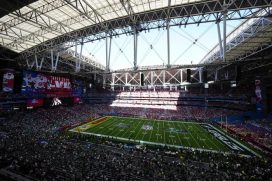Patrick Causey, on Twitter @PhillySportsPMC
Sam Bradford's career wasn't supposed to go this way. The former Heisman trophy winner was one of the most heralded quarterback prospects to come into the NFL in the last 10 years, and was picked to be the franchise savior of the St. Louis Rams.
However, two knee surgeries later, Bradford finds himself on a new team, in a new city, learning a new playbook. While he is undoubtedly upset about the way things turned out in St. Louis, he has found himself in a great situation — referring to the opportunity to play in Chip Kelly's offense as "a dream come true."
While we finally got a glimpse of Sam Bradford on Saturday night in the Eagles 40-17 thrashing of the Baltimore Ravens, it was only for one series. That is simply too small of a sample size from which to draw any meaningful conclusions about whether the Eagles made the right move trading for Bradford.
Perhaps the only thing we can put stock in is the fact that Bradford was hit — twice — and got back up (which I covered earlier this week here).
Fortunately, there is enough tape and scouting reports on Bradford to establish some parameters on what we might expect from Bradford in Chip Kelly's offense.
A College Prodigy
Sam Bradford won the Heisman trophy in his sophomore year, when he completed 68% of his passes, and threw for 4,720 yards, 50 touchdowns and only 8 interceptions.
While he missed mos of the following season because of a shoulder injury, Bradford parlayed that Heisman campaign into becoming the top pick in a loaded draft class that featured perennial Pro Bowlers Gerald Wallace, Nndamakung Suh, Earl Thomas, Dez Bryant and Demaryius Thomas.
But the St. Louis Rams did not just draft Bradford because he filled their giant need at quarterback. To the contrary, Bradford was one of the more decorated quarterback prospects to come along since the 2005.
Mike Mayock was on 94 WIP about a month ago and had the following to say on his evaluation of Bradford coming out of college:
"Sam Bradford, and I watched just about everyone of his tapes coming out of Oklahoma—and remember Rhea [Hughes], he had shoulder problems coming out of Oklahoma. So he’s always kind of had that durability stamp on him, that question…“So I thought he was one of the most accurate quarterbacks I’ve ever seen on tape coming out of college,” he continued. “There’s no denying his arm strength and his accuracy. The only issue is durability, and it’s a significant one. So I think the Eagles rolled the dice a little bit and said we can protect him better. We’ve got a better offensive line and we’re gonna run the hell out of the ball, which is a quarterback’s best friend."
In 2014, ESPN.com's Todd McShay released his top 10 prospects of the last five years — Bradford ranked 4th, just behind Andrew Luck, Von Miller and Luke Kuechly. That is high praise given the top end talent that has come out in the last five years — players like Suh, Wallace, RGIII, Jadeveon Clowney, AJ Green, Patrick Peterson and Julio Jones, to name a few.
Of course, scouting is an inexact science, as you can see from this list that I have compiled from Scouts Inc.'s quarterback prospect rankings dating back to the 2005 Draft.
Name |
Year |
Grade |
|
Andrew Luck |
2012 |
99 |
|
Aaron Rodgers |
2005 |
99 |
|
Alex Smith |
2005 |
98 |
|
Matt Leinart |
2006 |
98 |
|
JaMarcus Russell |
2007 |
98 |
|
Matt Ryan |
2008 |
98 |
|
Vince Young |
2006 |
97 |
|
Sam Bradford |
2010 |
97 |
|
Brady Quinn |
2007 |
97 |
|
Robert Griffin III |
2012 |
97 |
|
Jameis Winston |
2015 |
97 |
|
Jay Cutler |
2006 |
96 |
|
Matthew Stafford |
2009 |
96 |
|
Blaine Gabbert |
2011 |
96 |
|
Mark Sanchez |
2009 |
95 |
|
Ryan Tannehill |
2012 |
94 |
|
Cam Newton |
2011 |
93 |
|
Marcus Mariota |
2015 |
93 |
|
Brian Brohn |
2008 |
93 |
|
Blake Bortles |
2014 |
91 |
|
Chad Henne |
2008 |
90 |
|
Jake Locker |
2011 |
90 |
|
Johnny Manziel |
2014 |
90 |
In total, there are 23 quarterbacks that have received a grade of 90 or higher since the 2005 Draft. Six of them (26%) – Locker, Young, Russell, Leinart, Quinn and Brohn — are no longer in the league. Another four — Manziel, Henne, Sanchez and Gabbert — are not starters. And 12 of them are not even with the team that drafted them.
Those staggering numbers highlight the inherent risk associated with taking a quarterback high in the draft. Even the stone cold locks can fail to live up to the hype.
So is Bradford just another first round bust? Or is he simply a victim of circumstance, held back by an underwhelming supporting cast and overwhelming amount of bad luck?
Sam the Ram
Looking over Bradford's numbers, there isn't much by which we can be impressed. For his career, Bradford has completed only 58.6 percent of his passes, while throwing 59 touchdowns to 38 interceptions. Bradford went a combined 18-30-1 as a starter in St. Louis.
There are 26 active quarterbacks that have attempted at least 1,700 passes. Bradford is the only one who has averaged under 6.5 yards per attempt (he is at 6.3).
To put that in perspective, only Bradford, Matt Cassel and Mark Sanchez have completed less than 59% of their passes and averaged under 6.9 YPA. The fact that Kelly has two of those three quarterbacks on his roster should give you at least some pause for concern.
But Bradford might have been a victim of circumstance. As Eagles offensive coordinator Pat Shurmur recently said, "it takes two to tango when we are talking about completion percentages."
Looking over his list of supporting wide receivers is reminiscent of the early Donovan McNabb years in Philadelphia. Instead of James Thrash, Freddie Mitchell, and Todd Pinkston, Bradford played with the likes of Laurent Robinson, Danny Amendola, Danario Alexander, and Brandon Gibson.
But McNabb was able to make it work. So why couldn't Bradford?
For starters, his offensive line was not very good. In 2013, ProFootballFocus ranked the Rams pass blocking efficiency the 18th best in the NFL. Not terrible, but certainly not good either. In 2012, they ranked 19th. In 2011? 25th.
For comparisons sake, last year's Eagles offensive line — even with all of its injuries — ranked 9th.
And while Bradford's Rams had a strong running game with Pro Bowl running back Steven Jackson in the fold — he ran for 3,431 yards in Bradford's three seasons — there was little else in terms of talent on the roster.
Consider this: from 2010-2013, the years in which Bradford actually played games for the Rams, just two players made the Pro Bowl: Steven Jackson (2010), and John Hekker (2013).
John Hekker is a punter.
The Rams roster was a barren wasteland in terms of talent. It would have been unreasonable to expect Bradford to carry the Rams to the playoffs or any form of meaningful success. And while Jeff Fisher has improved the roster since taking over the team in 2012, most of those improvements have come on defense.
The Rams are still trying to solidify their offensive line and find playmakers on offense, an effort that they have repeatedly failed to accomplish. In the 2013 Draft, the Rams selected diminutive wide receiver Tayvon Austin with the eighth overall pick. Austin has caught only 71 passes for 660 yards and four touchdowns in two seasons in the league, which is the type of production you would expect from a fourth wide receiver, not a top 10 pick.
The lack of overall skill on the offensive side of the ball clearly hindered Bradford's development as a quarterback. So while Bradford's production so far has been underwhelming, it is not fair to pin that entirely on him.
Why Did Kelly Trade for Bradford?
For starters, Kelly was likely impressed with Bradford's decision making, a skill set he has routinely emphasized when speaking to reporters. Bradford's interception rate for his career is only 2.2 percent. Only Tom Brady and Aaron Rodgers have a better interception rate among quarterbacks with at least 1,500 attempts.
This point is further driven home by KC Joyner's bad decision rate ("BDR") metric, which, as you might have guessed, attempts to measure "how often a quarterback makes a mental error that leads to a turnover opportunity for the" other team. In 2013, Bradford posted a .7 percent BDR, which was tied for third best in the league.
We hear routinely how Kelly's offense is quarterback friendly. For example, Sanchez completed only 56.3 percent of his passes and averaged only 6.7 yards per attempt with the Jets. However, with the Eagles his numbers jumped to 64.1 percent and 7.8 YPA.
But while the offense improved Sanchez's stats, it did not improve Sanchez's interception rate. Perhaps Kelly is hoping for a similar rise in Bradford's completion and YPA, while maintaining Bradford's good decision making.
Kelly also had inside knowledge into the type of player Bradford was since Pat Shurmer was Bradford's offensive coordinator in his rookie year. Shurmer had high praise for Bradford after the trade was completed:
"I certainly have a very strong, good opinion of what he can accomplish. Had he been able to stay healthy, he wouldn't have been available for us. When the deal was getting made, I had my fingers crossed in the background that it was going to get done.
He can function very well, he can get rid of the ball quickly, he's very smart, he prepares and trains like all the great ones do, and we feel like he's an outstanding thrower. Not to mention he's a terrific athlete. There's kind of a three-prong challenge for him – get better physically, learn what we're doing mentally, and get out here and do it on the field tactically – and in our minds he's doing a good job."
Bradford not only has familiarity with Pat Shurmer, but he also has ran an up-tempo spread offense while at Oklahoma that is somewhat similar to Kelly's scheme here. Listen to how Sam Bradford described the Sooners scheme back in 2013:
"Our offense changed dramatically. We went no-huddle, fast break. We had 11 personnel, 10 personnel, smaller, faster and spread it out to start throwing the ball a lot more. I remember that first spring, I really wasn’t sure I was going to like it because I had never run the no-huddle before. It seemed like everything happened too fast but the more we did it, the more comfortable I got with it. It turned out; it was probably the best move we made because we were really good at it.”
Sound familiar? The same concepts Kelly relies on here — no huddle, fast break offense which relies primarily on 11 personnel — Bradford employed to great success in college.
Bradford's film with the Rams also shows that he excels in some of the main concepts that the Eagles run. Take this throw against the Arizona Cardinals:
As I covered in last week's All-22, crossing patterns are a staple in the Eagles offense. You can see that Bradford has great anticipation and fits the ball into a tight window.
He had a similar completion against the Cowboys
Bradford will never be mistaken for Brett Farve or Jay Cutler when it comes to arm strength. But he has enough arm strength to fit the ball into tight windows, like he did here against the Carolina Panthers, splitting four defenders 20-yards downfield:
One question about Bradford's game is whether he can consistently throw deep. The Eagles offense is predicated on taking calculated deep shots down the field — Kelly likes to stretch defenses both vertically and horizontally. The Eagles face a lot of single high looks given the respect afforded to their run game. In 2013, the Eagles led the league in plays of 20+ yards with 80. In 2014, they were third in the league with 63 20+ yard plays.
Given Bradford's historically low yards per attempt, it is fair to question whether he has the ability to stretch the field. However, he has flashed the ability to attack defenses down the field. Like this play, which was easily the best throw I've seen from Bradford, courtesy of PE.com
And this throw against the Panthers:
The Eagles also run a lot of play-action in their offense. While the Rams curiously only ran play-action on 19 percent of their passes per PFF.com, Bradford excelled in that regard. In 2013, Bradford completed 65.4% of his passes for 9.7 YPA, good for 111.5 passer rating, which ranked seventh in the league.
Given the investment the Eagles have made in the running back position this offseason — adding DeMarco Murray and Ryan Mathews to Darren Sproles — it is safe to assume that the Eagles' heavy reliance on the play-action pass will continue.
The achilles heel to Bradford so far — besides the injuries — is his woeful play when he is under pressure.
In 2013, Bradford completed only 38.8% of his attempts while averaging 5.0 YPA when he was under pressure. For comparison sake, Nick Foles completed 48.4% of his passes for 6.4 YPA in 2013 when he was under pressure.
So if you thought Foles got happy feet when he faced pressure, Bradford arguably might be worse.
Watch Bradford sail this throw into tight coverage, which led to an interception
The Eagles have questions along their offensive line this year after releasing Todd Herremans and Evan Mathis. While the first unit has looked impressive so far in preseason, it will be imperative for them to give Bradford time to throw. Not only so that it improves his chances of remaining healthy, but also so Bradford can avoid costly mistakes like these.
Overall
Kelly has routinely compared the acquisition of Bradford to when the New Orleans Saints acquired Drew Brees and the Denver Broncos signed Peyton Manning: “Peyton Manning switched teams because of an injury. Drew Brees switched teams because of an injury. So we went down that path."
Bradford has flashed arm talent that is on par with Manning and Brees. But for one reason or another, he has yet to put it all together into a Pro Bowl caliber career.
Kelly is confident that Bradford's skill set marries well with his up-tempo spread style offense, since it was similar to the one Bradford ran to great success at Oklahoma. As you've seen above, Bradford excels in several areas that are staples in the Eagles offense: crossing routes, timing throws, and throwing off the play-action.
If the Eagles can establish the run game and provide Bradford with enough time to throw, he could blossom into the franchise caliber quarterback the Eagles desperately need. If the offensive line falters, Bradford could struggle or worse, end up with another season ending injury.
Here's hoping we are celebrating the rebirth of Bradford's career in Philadelphia, not the end of it.







